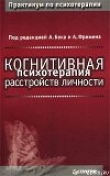
Текст книги "Психоаналитическая диагностика: Понимание структуры личности в клиническом процессе"
Автор книги: Нэнси Мак-Вильямс
Жанр:
Психология
сообщить о нарушении
Текущая страница: 40 (всего у книги 42 страниц)
Путнам (Putnam, 1989) и Росс (Ross, 1989) написали прекрасные фундаментальные тексты по диагностике и лечению диссоциативных состояний. Психоаналитически ориентированному читателю не надо отказываться от Росса из-за его несколько странного отношения к анализу. Его экспертное исследование огромно. Наиболее краткой статьей по множественной личности и диссоциации из всех, что я знаю, является обзор Клафта (Kluft’a, 1991). Глава о множественной личности в антологии Клафта и Файна (Kluft & Fine, 1993) очень хороша и постоянно читается.
Литература
Abraham, K. (1924). A short study of the development of the libido, viewed in light of mental disorders. In Selected papers on psycho-analysis (pp. 418–501). London: Hogarth Press, 1927.
Abraham, K. (1935). The history of a swindler. Psychoanalytic Quarterly, 4, 570–587.
Abrahamsen, D. (1985). Confessions of Son of Sam. New York: Columbia University Press.
Adler, A. (1927). Understanding human nature. Garden City, NY: Garden City Publishing.
Adler, G. (1972). Hospital management of borderline patients and its relationship to psychotherapy. In P. Hartcollis (Ed.), Borderline personality disorders: The concept, the syndrome, the patient (pp. 307–323). New York: International Universities Press.
Adler, G. (1973). Hospital treatment of borderline patients. American Journal of Psychiatry, 130, 32–36.
Adler, G, (1985). Borderline psychopathology and its treatment. New York: Jason Aronson.
Adler, G., & Buie, D. (1979). The psychotherapeutic approach to aloneness in the borderline patient. In J. LeBoit & A. Capponi (Eds.), Advances in psychotherapy of the borderline patient (pp. 433–448). New York: Jason Aronson.
Adomo, T.W., Frenkl-Brunswick, E., Levinson, D.J., & Sanford, R.N. (1950). The authoritarian personality. New York: Harper. Aichhom, A. (1936). Wayward youth. London: Putnam.
Akhtar, S. (1992). Broken structures: Severe personality disorders and their treatment. Northvale, NJ: Jason Aronson.
Akiskal, H.S. (1984). Characterologic manifestations of affective disorders: Toward a new conceptualization. Integrative Psychiatry, 2, 83–88.
Allen, D.W. (1977). Basic treatment issues. In M.J. Horowitz (Ed.), Hysterical personality (pp. 283–328). New York: Jason Aronson.
Altschul, S. (Ed.). (1988). Childhood bereavement and its aftermath. Madison, CT: International Universities Press.
American Psychiatric Association. (1968). Diagnostic and statistical manual of mental disorders (2nd ed.). Washington, DC: Author.
American Psychiatric Association. (1980). Diagnostic and statistical manual of mental disorders (3rd ed.). Washington, DC: Author.
American Psychiatric Association. (1987). Diagnostic and statistical manual of mental disorders (3rd ed., rev.). Washington, DC: Author.
American Psychiatric Association. (1993, March 1). DSM – 1V draft criteria. Washington, DC: Author.
Arieti, S. (1955). Interpretation of schisophrenia. New York: Brunner/Mazel.
Arieti, S. (1961). Introductory notes on the psychoanalytic therapy of schizophrenics. In A. Burton (Ed.), Psychotherapy of the psychoses (pp. 68–89). New York: Basic Books.
Arieti, S. (1974). Interpretation of schizophrenia (2nd ed.). New York: Basic Books.
Arlow, J.A., & Brenner, C. (1964). Psychoanalytic concepts and the structural theory. New York: International Universities Press.
Aronson, M.L. (1964). A study of the Freudian theory of paranoia by means of the Rorschach Test. In C.F. Reed, I.E. Alexander, & S.S. Tomkins (Eds.), Psychopathology: A source book (pp. 370–387). New York: Wiley.
Ashe, S.S. (1985). The masochistic personality. In R. Michels & J. Cavenar (Eds.), Psychiatry 1 (pp. 1–9). Philadelphia: Lippincott.
Bach, S. (1985). Narcissistic states and the therapeutic process. New York: Jason Aronson.
Bak, R.C. (1946). Masochism in paranoia. Psychoanalytic Quarterly, 15, 285–301.
Balint, M. (1945). Friendly expanses – Horrid empty spaces. International Journal of Psycho-Analysis, 36, 225–241.
Balint, M. (1960). Primary narcissism and primary love. Psychoanalytic Quarterly, 29, 6—43.
Balint, M. (1968). The basic fault: Therapeutic aspects of regression. London: Tavistock.
Bateson, G., Jackson, D.D., Haley, J., & Weakland, J. (1956). Toward a theory of schizophrenia. Behavioral Science, 1, 251–264.
Baumeister, R.F. (1989). Masochism and the self. Hillsdale, NJ: Lawrence Erlbaum.
Bellak, L., & Small, L. (1978). Emergency psychotherapy and brief psychotherapy. New York: Grune & Stratton.
Beres, D. (1958). Vicissitudes of superego formation and superego precursors in childhood. Psychoanalytic Study of the Child, 13, 324–335.
Bergler, E. (1949). The basic neurosis. New York: Grune & Stratton.
Bergman, P., & Escalona, S.K. (1949). Unusual sensitivities in very young children. Psychoanalytic Study of the Child, 3/4, 333–352.
Bergmann, M.S. (1985). Reflections on the psychological and social functions of remembering the Holocaust. Psychoanalytic Inquiry, 5, 9—20.
Bergmann, M.S. (1987). The anatomy of loving: The story of man’s quest to know what love is. New York: Columbia University Press.
Berliner, B. (1958). The role of object relations in moral masochism. Psychoanalytic Quarterly, 27, 38–56.
Bernstein, D. (1993). Female identity conflict in clinical practice. Northvale, NJ: Jason Aronson.
Bernstein, E.M., & Putnam, F.W. (1986). Development, reliability, and validity of a dissociation scale. Journal of Mental and Nervous Disease, 179, 727–735.
Bernstein, I. (1983). Masochistic psychology and feminine development. Journal of the American Psychoanalyric Association, 31, 467–486.
Bertin, C. (1982). Marie Bonaparte: A life. New York: Quarter Books.
Bettelheim, B. (1960). The informed heart: Autonomy in a mass age. Glencoe, IL: The Free Press.
Bettelheim, B. (1983). Freud and man’s soul. New York: Knopf.
Bibring, E. (1953). The mechanism of depression. In P. Greenacre (Ed.),
Affective disorders (pp. 13–48). New York: International Universities Press.
Bion, W.R. (1959). Experiences in groups. New York: Basic Books.
Bion, W.R. (1967). Second thoughts. New York: Jason Aronson.
Biondi, R., & Hecox, W. (1992). The Dracula killer: The true story of California’s vampire killer. New York: Pocket Books.
Blanck, G., R Blanck, R. (1974). Ego psychology: Theory and practice. New York: Columbia University Press.
Blanck, G., & Blanck, R. (1979). Ego psychology II: Psychoanalytic developmental psychology. New York: Columbia University Press.
Blanck, G., & Blanck, R. (1986). Beyond ego psychology: Developmental object relations theory. New York: Columbia University Press.
Blanck, R., & Blanck, G. (1968). Marriage and personal development. New York: Columbia University Press.
Blatt, S.J. (1974). Levels of object representation in anaclitic and introjective depression. Psychoanalytic Study of the Child, 24, 107–157.
Blatt, S.J., & Bers, S. (1993). The sense of self in depression: A psychoanalytic perspective. In Z.V. Segal & S.J. Blatt (Eds.), The self in emotional distress: Cognitive and psychodynamic perspectives (pp. 171–210). New York: Guilford Press.
Bleuler, E. (1911). Dementia praecox or the group of schizophrenias (J. Zinkin, Trans.). New York: International Universities Press, 1950.
Bleuler, M. (1977), The schizophrenic disorders (S.M. Clemens, Trans.). New Haven: Yale University Press.
Bollas, C. (1987). Loving hate. In The shadow of the object (pp. 117–134). New York: Columbia University Press.
Bomstein, B. (1949). The analysis of a phobic child: Some problems of theory and technique in child analysis. Psychoanalytic Study of the Child, 3/4, 181–226.
Bowlby, J. (1969). Attachment and loss: Vol. I. Attachment. New York: Basic Books.
Bowlby, J. (1973). Attachment and loss: Vol. 11. Separation: Anxiety and anger. New York: Basic Books.
Braude, S.E. (1991). First person plural: Multiple personality and the philosophy of mind. New York: Routledge, Chapman & Hall.
Braun, B. G, (1984). Hypnosis creates multiple personality: Myth or reality? International Journal of Clinical Hypnosis, 32, 191–197.
Braun, B.G. (1988). The BASK (behavior, affect, sensation, knowledge) model of dissociation. Dissociation, 1, 4—23.
Braun, B.G., & Sacks, R.G. (1985). The development of multiple personality disorder: Predisposing, precipitating, and perpetuating factors. In R.P. Kluft (Ed.), Childhood antecedents of mulriple personality (pp. 37–64). Washington, DC: American Psychiatric Press.
Brazelton, T.B. (1962). Observations of the neonate. Journal of the American Academy of Child Psychiatry, 1, 38–58.
Brazelton, T.B. (1980, May). New knowledge about the infant from current research: Implications for psychoanalysis. Paper presented at the meeting of the American Psychoanalytic Association, San Francisco.
Brazelton, T.B. (1982). Joint regulation of neonate-parent behavior. In E. Tronick (Ed.), Social interchange in infancy. Baltimore: University Park Press.
Brenman, M. (1952). On teasing and being teased and the problems of “moral masochism.” Psychoanalytic Study of the Child, 7, 264–285.
Brenner, C. (1955). An elementary textbook of psychoanalysis. New York: International Universities Press.
Brenner, C. (1959). The masochistic character. Journal of the American Psychoanalytic Association, 7, 197–226.
Brenner, C. (1982). The calamities of childhood. In The mind in conflict (pp. 93—106). New York: International Universities Press.
Breuer, J., & Freud, S. (1893–1895). Studies in hysteria. Standard Edition, 2, 21A7.
Brody, S., & Siegel, M. (1992). The evolution of character: Birth to eighteen years. A longitudinal study. New York: International Universities Press.
Brown, R. (1965). Social psychology. New York: The Free Press.
Buckley, P. (Ed.). (1988). Essential papers on psychosis. New York: New York University Press.
Bursten, B. (1973a). The manipulator: A psychoanalytic view. New Haven: Yale University Press.
Bursten, B. (1973b). Some narcissistic personality types. international Journal of Psycho-Analysis, 54, 287–300.
Cameron, N. (1959). Paranoid conditions and paranoia. In S. Arieti (Ed.), American handbook of psychiatry (Vol. 1, pp. 508–539). New York: Basic Books.
Capote, T. (1965). In cold blood. New York: Random House.
Casey, J.F. (1991). The flock: The autobiography of a multiple personality (with L. Wilson). New York: Knopf.
Cath, S.H. (1986). Fathering from infancy to old age: A selective overview of recent psychoanalytic contributions. Psychoanalytic Review, 74, 469–479.
Cattell, J.P., & Cattell, J. S, (1974). Depersonalization: Psychological and social perspectives. In S. Arieti (Ed.), American handbook of psychiatry (pp. 767–799). New York: Basic Books.
Celani, D. (1976). An interpersonal approach to hysteria. American Journal of Psychiatry, 133, 1414–1418.
Chase, T. (1987). When Rabbit howls. New York: Jove.
Chasseguet-Smirgel, J. (1971). Female sexuality: New psychoanalytic views. Ann Arbor: University of Michigan Press.
Chasseguet-Smirgel, J. (1984). Creativity and perversion. London: Free Association.
Chasseguet-Smirgel, J. (1985). The ego ideal: A psychoanalytic essay on the malady of the idea. New York: Norton.
Chess, S., Rutter, M., Thomas, A., & Birch, H.G. (1963). Interaction of temperament and the environment in the production of behavioral disturbances in children. American Journal of Psychiatry, 120, 142–147.
Chess, S., Thomas, A., & Birch, H.G. (1967). Behavior problems revisited: Findings of an anteretrospective study. Journal of the American Academy of Child Psychiatry, 6, 321–331.
Chessick, R.D. (1969). How psychotherapy heals: The process of intensive psychotherapy. New York: Jason Aronson.
Chessick, R.D. (1985). Psychology of the self and the treatment of narcissism. Northvale, NJ: Jason Aronson.
Chodoff, P. (1978). Psychotherapy of the hysterical personality disorder. Journal of the American Academy of Psychoanalysis, 6, 496–510.
Chodoff, P. (1982). The hysterical personality disorder: A psychotherapeutic approach. In A. Roy (Ed.), Hysteria (pp. 277–285). New York: Wiley.
Chodorow, N.J. (1978). The reproduction of mothering: Psychoanalysis and the sociology of gender. Berkeley: University of California Press.
Chodorow, N.J. (1989). Feminism and psychoanalytic theory. New Haven: Yale University Press.
Cleckley, H. (1941). The mask of sanity: An attempt to clarify some issues about the so-called psychopathic personality. St. Louis: Mosby.
Cohen, M.B., Baker, G., Cohen, R.A., Fromm-Reichmann, F., & Weigert, E. (1954). An intensive study of twelve cases of manic – depressive psychosis. Psychiatry, 17, 103–137.
Colby, K. (1951). A primer for psychotherapists. New York: Ronald.
Coleman, M., & Nelson, B. (1957). Paradigmatic psychotherapy in borderline treatment. Psychoanalysis, 5, 28–44.
Coons, P.M., Bowman, E.S., & Milstein, V. (1988). Multiple personality disorder: A clinical investigation of 50 cases. Journal of Nervous and Mental Disease, 176, 519–527.
Coons, P.M., &. Milstein, V. (1986). Psychosexual disturbances in multiple personlity. Journal of Nervous and Mental Disease, 174, 106–110.
Coontz, S. (1992). The quay we never were: American families and the nostalgia gap. New York: Basic Books.
Cooper, A.M. (1988). The narcissistic – masochistic character. In R.A. Glick &. D.I. Meyers (Eds.), Masochism: Current psychoanalytic perspecrives (pp. 189–204). Hillsdale, NJ: The Analytic Press.
Darley, J., R Batson, C.D. (1973). From Jerusalem to Jericho: A study of situational and dispositional variables in helping behavior. Journal of Personality and Social Psychology, 27, 100–108.
Davanloo, H. (1978). Basic principles and techniques in short-term dynamic psychotherapy. New York: Spectrum.
Davanloo, H, (1980). Short-term dynamic psychotherapy. New York: Jason Aronson. de Monchy, R. (1950). Masochism as a pathological and as a normal phenomenon in the human mind. International Journal of Psycho-Analysis, 31, 95–97.
Deri, S. (1968). Interpretation and language. In E. Hammer (Ed.), The use of interpretation in treatment. New York: Grune & Stratton.
Des Barres, P. (1987). I’m with the band: Confessions of a groupie. New York: Morrow.
Deutsch, H. (1942). Some forms of emotional disturbance and their relationship to schizophrenia. Psychoanalytic Quarterly, 11, 301–321.
Deutsch, H. (1944). The psychology of women: A psychoanalytic interpretation: Vol. 1. Girlhood. New York: Grune R Stratton.
Deutsch, H. (1955). The impostor: Contribution to ego psychology of a type of psychopath. Psychoanalytic Quarterly, 24, 483–503.
Diamond, M.J. (1993, April). Fathers and sons: Psychoanalytic perspectives on “good-enough” fathering throughout the life cycle. Paper presented ar. the Spring Meeting of the Division of Psychoanalysis (39) of the American Psychological Association, New York.
Dinnerstein, D. (1976). The mermaid and the minotaur. New York: Harper & Row.
Dorpat, T. (1982). An object-relations perspective on masochism. In P.L. Giovacchini & L.B. Boyer (Eds.), Technical factors in the treatment of severely disturbed patients (pp. 490–513). New York: Jason Aronson.
Easser, B.R., & Lesser, S. (1965). The hysterical personality: A reevaluation. Psychoanalytic Quarterly, 34, 390–405.
Edelstein, M.G. (1981). Trauma, tmnce, and transformation: A clinical guide to hypnotherapy. New York: Brunner/Mazel.
Ehrenberg, D.B. (1992). The intimate edge: Extending the reach of psychoanalytic interaction. New York: Norton.
Eigen, M. (1986). The psychotic core. New York: Jason Aronson.
Eissler, K.R. (1953). The effects of the structure of the ego on psychoanalytic technique. Journal of the American Psychoanalyric Association, 1, 104–143.
Ekstein, R., & Wallerstein, R.S. (1958; rev. ed., 1971). The teaching and learning of psychotherapy. Madison, CT: International Universities Press.
Ellis, A. (1961). The treatment of a psychopath with rational emotive psychotherapy. In Reason and emorion in psychotherapy (pp. 288–299). New York: Lyle Stewart.
Erikson, E.H. (1950). Childhood and society. New York: Norton.
Erikson, E.H. (1968), identity: Youth and crisis. New York: Norton.
Escalona, S.K. (1968). The roots of individuality: Normal patterns of development in infancy. Chicago: Aldine.
Fairbaim, W.R.D. (1941). A revised psychopathology of the psychoses and psychoneuroses. International Journal of Psycho-Analysis, 22, 250–279.
Fairbaim, W.R.D. (1954). An object-relations theory of the personality. New York: Basic Books.
Fast, I. (1990). Aspects of early gender development: Toward a reformulation. Psychoanalytic Psychology, 7 (Suppl.), 105–107.
Fedem, P. (1952). Ego psychology and the psychoses. New York: Basic Books.
Fenichel, O. (1928). On “isolation.” In The collected papers of Otto Fenichel, first series (pp. 147–152). New York: Norton.
Fenichel, O. (1941). Problems of psychoanalytic technique. Albany, NY: Psychoanalytic Quarterly.
Fenichel, O. (1945). The psychoanalytic theory of neurosis. New York: Norton.
Ferenczi, S. (1913). Stages in the development of a sense of reality. In First contributions to psycho-analysis (pp. 213–239). New York: Brunner/Mazel, 1980.
Ferenczi, S. (1925). Psychoanalysis of sexual habits. Further contributions to the theory and technique of psycho-analysis (pp. 259–297). New York: Brunner/ Mazel, 1980.
Finell, J. (1986). The merits and problems with the concept of projective identification. Psychoanalytic Review, 73, 103–120.
Fisher, S. (1970). Body experience in fantasy and behavior. New York: Appleton-Century-Crofts.
Fisher, S., & Greenberg, R.P. (1985). The scientific credibility of Fremi’s theories and therapy. New York: Columbia University Press.
Fogelman, E. (1988). Intergenerational group therapy: Child survivors of the Holocaust and offspring of survivors. Psychoanalyric Review, 75, 619–640.
Fogelman, E., & Savran, B. (1979). Therapeutic groups for children of Holocaust survivors. International Journal of Group Psychotherapy, 29, 211–235.
Fonda, H. (1981). My life. As told to Howard Teichmann. New York: New American Library.
Forster, E.M. (1921). Howard’s End. New York: Vintage.
Fraiberg, S. (1959). The magic years: Understanding and handling the problems of early chiMhood. New York: Charles Scribner’s Sons.
Frances, A., & Cooper, A.M. (1981). Descriptive and dynamic psychiatry: A perspective on DSM-III. American Journal of Psychiatry, 138, 1198–1202.
Frank, J.D., Margolin, J., Nash, H.T., Stone, A.R., Varon, E., R Ascher, E. (1952). Two behavior patterns in therapeutic groups and their apparent motivation. Human Relations, 5, 289–317.
Freud, A. (1936). The ego and the mechanisms of defense. New York: International Universities Press, 1966.
Freud, S. (1886). Observation of a severe case of hemianaesthesia in a hysterical male. Standard Edition, 1, 23–31.
Freud, S. (1897). Letter to Wilhelm Fliess. Standard Edition, 1, 259.
Freud, S. (1900). The interpretation of dreams. Standard Edition, 4.
Freud, S. (1901). The psychopathology of everyday life. Standard Edition, 6.
Freud, S. (1905). Three essays on the theory of sexuality. Standard Edition, 7, 135–243.
Freud, S. (1908). Character and anal eroticism. Standard Edition, 9, 169–175.
Freud, S. (1909). Notes upon a case of obsessional neurosis. Standard Edition, 10, 151–320.
Freud, S. (1911). Psycho-analytic notes on an autobiographic account of a case of paranoia (dementia paranoides). Standard Editicm, 13, 1—162.
Freud, S. (1912). The dynamics of transference. Standard Edition, 12, 97—108.
Freud, S. (1913). The disposition to obsessional neurosis. Standard Edition, 12, 311–326.
Freud, S. (1914a). Remembering, repeating and working through (Further recommendations on the technique of psycho-analysis II). Standard Edition, 12, 147–156.
Freud, S. (1914b). On narcissism: An introduction. Standard Edition, 14, 67—102.
Freud, S. (1915a). Instincts and their vicissitudes. Standard Edition, 14, 111–140.
Freud, S. (1915b). Repression. Standard Edition, 14, 147.
Freud, S. (1916). Some character types met with in psychoanalytic work. Standard Edition, 14, 311–333.
Freud, S. (1917a). Mourning and melancholia. Standard Edition, 14, 243–258.
Freud, S. (1917b). On transformations of instinct as exemplified in anal erotism. Standard Edition, 17, 125–133.
Freud, S. (1918). From the history of an infantile neurosis. Standard Edition, 17, 7—122.
Freud, S. (1919). A child is being beaten: A contribution to the study of the origin of sexual perversions. Standard Edition, 17, 179–204.
Freud, S. (1920). Beyond the pleasure principle. Standard Edition, 18, 7—64.
Freud, S. (1923). The ego and the id. Standard Edition, 19, 13–59.
Freud, S. (1924). The economic problem in masochism. Standard Edition, 19, 159–170.
Freud, S. (1925a). Some psychical consequences of the anatomical distinction between the sexes. Standard Edition, 19, 248–258.
Freud, S. (1925b). Autobiographical study. Standard Edition, 20, 32–76.
Freud, S. (1931). Libidinal types. Standard Edition, 21, 215–222.
Freud, S. (1932). Femininity. Standard Edition, 22, 112–135.
Freud, S. (1937). Analysis terminable and interminable. Standard Edition, 22, 216–253.
Freud, S. (1938). An outline of psycho-analysis. Standard Edition, 23, 144–207.
Friedenberg, E.Z. (1959). The vanishing adolescent. Boston: Beacon.
Friedman, R.C. (1988). Male homosexuality: A contemporary psychoanalytic perspective. New Haven: Yale University Press.
Fromm, E. (1947). Man for himself: An inquiry into the psychology of ethics. New York: Rinehart.
Fromm-Reichmann, F. (1950). Principles of intensive psychotherapy. Chicago: University of Chicago Press.
Frosch, J. (1964). The psychotic character: Clinical psychiatric considera tions. Psychoanalytic Quarterly, 38, 91–96.
Furman, E. (1982). Mothers have to be there to be left. Psychoanalytic Study of the Child, 37, 15–28.
Gabbard, G.O. (1990). Psychodynamic psychiatry in clinical practice. Washing ton, DC: American Psychiatric Press.
Gaddis, T., &. Long, J. (1970). Killer: A journal of murder. New York: Macmillan.
Galenson, E. (1988). The precursors of masochism: Protomasochism. In R.A. Glick & D.I. Meyers (Eds.), Masochism: Cun’ent psychoanalytic perspectives (pp. 189–204). Hillsdale, NJ: The Analytic Press.
Galin, D. (1974). Implications for psychiatry of left and right cerebral specialization. Archives of General Psychiatry, 31, 572–583.
Gardiner, M. (1971). The wolf-man: By the cuolf-man. New York: Basic Books.
Gardner, M.R. (1991). The art of psychoanalysis: On oscillation and other matters. Journal of the American Psychoanalytic Association, 39, 851–870.
Gay, P. (1968). Weimar culture. New York: Harper & Row.
Gay, P. (1988). Freud: A life for our time. New York: Norton.
Gaylin, W. (Ed.). (1983). Psychodynamic understanding of depression: The meaning of despair. New York: Jason Aronson.
Gill, M.M. (1983). The interpersonal paradigm and the degree of the therapist’s involvement. Contemporary Psychoanalysis, 19, 200–237.
Gill, M.M, Newman, R., & Redlich, F.C. (1954). The initial interview in psychiatric practice. New York: International Universities Press.
Gilligan, C. (1982). In a different voice: Psychological theory and women’s development. Cambridge, MA: Harvard University Press.
Giovacchini, P.L. (1979). The treatment of primitive mental states. New York: Jason Aronson.
Giovacchini, P.L. (1986). Developmental disorders: The transitional space in mental breakdoum and crearive imagination. Northvale, NJ: Jason Aronson.
Giovacchini, P.L., & Boyer, L. B, (Eds.). (1982). Technical factors in the treatment of the severely disturbed patient. New York: Jason Aronson.
Glick, R.A., &. Meyers, D.I. (1988). Masochism: Current psychoanalytic perspectives. Hillsdale, NJ: The Analytic Press.
Glover, E. (1955). The technique of psycho-analysis. New York: International Universities Press.
Goldberg, A. (1990a). Disorders of continuity. Psychoanalytic Psychology, 7, 13–28.
Goldberg, A. (1990b). The prisonhouse of psychoanalysis. New York: The Analytic Press.
Goldstein, K. (1959). Functional disturbances in brain damage. In S. Arieti (Ed.), American handbook of psychiatry (Vol. 1, pp. 770–794). New York: Basic Books.
Gottesman, I. (1991). Schigophrenia genesis: The origins of madness. New York: W.H. Freeman.
Green, H. (1964). I never promised you a rose garden. New York: Holt, Rinehart & Winston.
Greenacre, P. (1958). The impostor. Psychoanalytic Quarterly, 27, 359–382.
Greenberg, J.R., & Mitchell, S.A. (1983). Object relations in psychoanalytic theory. Cambridge, MA: Harvard University Press.
Greenfield, S. (1991). Experiences of subsequent therapists with female patients sexually involved with a prior male therapist. Unpublished doctoral dissertation. Graduate School of Applied and Professional Psychology, Rutgers University. Dissertarion Abstracts International, 52, 3905 B.
Greenson, R.R. (1967). The technique and practice of psychoanalysis. New York: International Universities Press.
Greenspan, S.I. (1981). Clinical infant re>arts: Number 1: Psychopathology and adaptation in infancy and early childhood: Principles of clinical diagnosis and preventive intervention. New York: International Universities Press.
Greenwald, H. (1958). The call girl: A sociological and psychoanalytic study. New York: Ballantine Books.
Greenwald, H. (1974). Treatment of the psychopath. In H. Greenwald (Ed.), Active psychotherapy (pp. 363–377). New York: Jason Aronson.
Grinker, R.R., Werble, B., & Drye, R.C. (1968). The borderline syndrome: A behavioral study of ego functions. New York: Basic Books.
Grossman, W. (1986). Notes on masochism: A discussion of the history and development of a psychoanalytic concept. Psychoanalytic Quarterly, 55, 379–413.
Groth, A.N. (1979). Men who rape: The psychology of the offender. New York: Plenum.
Grotstein, J. (1982). Newer perspectives in object relations theory. Contemporary Psychoanalysis, 18, 43–91.
Griinbaum, A. (1979). Is Freudian psychoanalysis pseudo-scientific by Karl Popper’s criterion of demarcation. American Philosophical Quarterly, 16, 131–141.
Grunberger, B. (1979). Narcissism: Psychoanalytic essays (J. Diamanti, Trans.). New York: International Universities Press.
Gunderson, J.G. (1984). Borderline personality disorder. Washington, DC: American Psychiatric Press.
Gunderson, J.G., & Singer, M.T. (1975). Defining borderline patients: An overview. American Journal of Psychiatry, 133, 1—10.
Guntrip, H. (1952). The schizoid personality and the external world. In Schizoid phenomena, object relations and the self (pp. 17–48). New York: International Universities Press, 1969.
Guntrip, H. (1961). The schizoid problem, regression, and the struggle to preserve an ego. In Schizoid phenomena, object relations and the self (pp. 49–86). New York: International Universities Press, 1969.
Guntrip, H. (1969). Schizoid phenomena, object relations and the self. New York: Intemational Universities Press.
Guntrip, H. (1971). Psychoanalytic theory, therapy, and the self: A basic guide to the human personality in Freud, Erikson, Klein, SuUivan, Fairbairn, Hartmann, Jacobson, and Winnicott. New York: Basic Books.
Hall, C.S. (1954). A primer on Freudian psychology. New York: Octagon Books (reprinted 1990).
Halleck, S.L. (1967). Hysterical personality traits – psychological, social, and iatrogenic determinants, Archives of General Psychiatry, 16, 750–759.
Hammer, E. (1968). The use of interpretation in treatment. New York: Grune & Stratton.
Hammer, E. (1990). Reaching the affect: Style in the psychodynamic therapies. New York: Jason Aronson.
Hare, R. (1970). Psychopathy: Theory and research. New York: Wiley.
Harris, D. (1982). Dreams die hard: Three men’s journey through the sixties. New York: St. Martin’s/Marek.
Hartcollis, P. (Ed.). (1977). Borderline personality disorders: The concept, the syndrome, the patient. New York: International Universities Press.
Hartmann, H. (1958). Ego psychology and the problem of adaptation. New York: International Universities Press.
Hedges, L.E. (1983). Listening perspectives in psychotherapy. New York: Jason Aronson.
Hendin, H. (1975). The age of sensation: A psychoanalytic exploration. New York: Norton.
Herman, J.L. (1981). Father-daughter incest. Cambridge, MA: Harvard University Press.
Herman, J.L. (1992). Trauma and recovery: The aftermath of violence – from domestic abuse to political terror. New York: Basic Books.
Herman, J.L., & Schatzow, E. (1987). Recovery and verification of memories of childhood sexual abuse. Psychoanalytic Psychology, 4, 1—14.
Herzog, J. (1980). Sleep disturbance and father hunger in 18– to 28– month – old boys: The Erlkonig syndrome. Psychoanalytic Study of the Child, 35, 219–236.
Hirsch, S.J., R Hollender, M.H. (1969). Hysterical psychoses: Clarification of the concept. American Journal of Psychiatry, 125, 909.
Hoch, P.H., & Polatin, P. (1949). Pseudoneurotic forms of schizophrenia. Psychoanalytic Quarterly, 23, 248–276.
Hoenig, J. (1983). The concept of schizophrenia: Kraepelin – Bleuler – Schneider. British Journal of Psychiatry, 142, 547–556.
Hollender, M.H. (1971). Hysterical personality. Comments on Contem-porary Psychiatry, 1, 17–24.
Hollender, M., & Hirsch, S. (1964). Hysterical psychosis. American Journal of Psychiatry, 120, 1066–1074.
Homer, A.J. (1979). Object relations and the developing ego in therapy. New York: Jason Aronson.
Homer, A.J. (1990). The primacy of structure: Psychotherapy of underlying character pathology, Northvale, NJ: Jason Aronson.
Homer, A.J. (1991). Psychoanalytic object relations therapy. Northvale, NJ: Jason Aronson.
Homey, K. (1926). The flight from womanhood: The masculinity-complex in women as viewed by men and women. international Journal of Psycho Analysis, 7, 324–339.
Homey, K. (1939). Nehru ways in psycho-analysis. New York: Norton.
Horowitz, M.J. (Ed). (1977). Hysterical personality. New York: Jason Aronson.
Hughes, J.M. (1989). Reshaping the psychoanalytic domain: The work of Melanic Klein, W.R.D. Fairbairn, and D.W. Winnicott, Berkeley, CA: University of California Press.
Isaacs, K. (1990). Affect and the fundamental nature of neurosis. Psychoana lytic Psychology, 7, 259–284.








